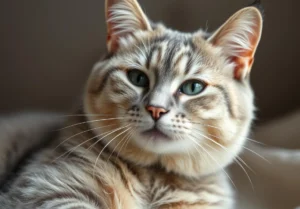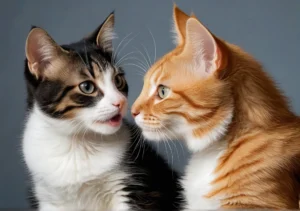Cats are known for their independent and sometimes mysterious nature. One moment they may be purring contentedly in your lap, and the next they could be hissing and swatting at you for no apparent reason. This unpredictable behavior often leaves cat owners wondering, “Why do cats get angry?”
While each cat is unique and may have different triggers for their anger, there are some common reasons why cats may exhibit aggressive behavior. Understanding these reasons can help cat owners better care for their feline companions and create a harmonious relationship with them.
Instinctual Behavior
Cats are fascinating creatures with a rich history of wild instincts that still influence their behavior today. When your furry feline friend gets angry, it could be due to their innate hunting and territorial instincts kicking in. Hunting instincts drive cats to stalk and pounce on prey, even if it’s just a toy or a moving shadow. If your cat perceives you or another pet as a potential prey, they might show signs of aggression. Territorial behaviors also play a significant role in a cat’s anger. Cats are known for marking their territory by scratching, rubbing, or spraying, and they can get upset when they feel their space is being invaded.
Fear and Anxiety
Just like humans, cats can experience fear and anxiety that trigger their anger. Loud noises, sudden movements, or unfamiliar environments can make your cat feel scared and threatened, leading to aggressive behavior. It’s essential to create a safe and comfortable space for your cat to reduce stress and anxiety. Providing hiding spots, calming pheromones, or interactive toys can help alleviate these negative emotions. Remember, a fearful cat is more likely to lash out in anger, so understanding and addressing their fears is crucial for a harmonious relationship.
Additional unique insight: – Cats have a unique way of expressing fear through subtle body language cues. Dilated pupils, flattened ears, raised fur, and a flicking tail are signs that your cat is feeling anxious or afraid. By recognizing these signals, you can intervene before your cat’s fear escalates into anger.
Remember, understanding the reasons behind your cat’s anger is the first step towards creating a peaceful and loving environment for both of you. By acknowledging their instincts, fears, and anxieties, you can help your cat feel secure and content, leading to a happier and healthier bond between you and your feline friend.
Medical Issues
Underlying medical issues can cause cats to exhibit anger and aggression. Pain, discomfort, or illness may trigger aggressive behavior in cats. If your feline friend is acting out of character, it’s crucial to schedule regular veterinary check-ups to rule out any potential medical causes for their behavior. Keep an eye out for subtle changes in your cat’s behavior, as they might be trying to communicate their distress through aggression. Remember, a healthy cat is a happy cat, so prioritize your pet’s health and well-being.
Socialization and Training
Proper socialization and training play a key role in preventing and managing aggressive behavior in cats. Early socialization helps kittens learn appropriate behavior and develop good manners. Positive reinforcement training techniques can be highly effective in teaching cats how to express themselves without resorting to aggression. Spend quality time with your cat, provide interactive toys, and create a stimulating environment to promote mental and physical well-being. Remember, a well-socialized and trained cat is more likely to be calm, confident, and content.
Additional Unique Insight:
When addressing aggressive behavior in cats, consider using pheromone products like diffusers or sprays. These products can help create a calming environment for your cat and reduce stress-related aggression. Consult with your veterinarian about incorporating pheromone products into your cat’s behavioral management plan for a holistic approach to addressing aggression.
Environmental Factors
Cats can easily get angry due to various environmental factors that disrupt their routine or sense of security. Moving to a new house, loud noises, or the addition of a new pet can all trigger stress and lead to aggressive behavior in our feline friends. To help mitigate these stressors, create designated safe spaces in your home where your cat can retreat, away from commotion. Additionally, maintain a consistent routine for feeding and playtime to provide stability and predictability for your cat. Ensuring a calm environment and giving your cat time to adjust to changes can go a long way in preventing anger outbursts.
Play and Mental Stimulation
Providing adequate playtime and mental stimulation for your cat is crucial in preventing boredom and reducing the likelihood of aggressive behavior. Cats are natural hunters and need opportunities to engage in interactive play to satisfy their instincts. Invest in toys that mimic hunting behavior, such as feather wands or laser pointers, to keep your cat physically and mentally active. Consider rotating toys regularly to keep things interesting for your feline companion. Moreover, set aside time each day to engage in play sessions with your cat to strengthen your bond and provide much-needed mental stimulation.
Key Tips for Mental Stimulation: 1. Interactive Puzzle Toys: Challenge your cat’s mind with puzzle feeders or interactive toys that dispense treats. 2. Scratching Posts: Provide multiple scratching posts to satisfy your cat’s natural urge to scratch and stretch. 3. Window Perches: Create a cozy spot by the window for your cat to watch birds and soak up some sun. 4. Training Sessions: Teach your cat simple tricks or commands using positive reinforcement to keep their mind sharp. 5. Catnip and Cat Grass: Offer catnip or cat grass for sensory enrichment and to stimulate their senses.
By prioritizing your cat’s mental and physical well-being, you can help prevent anger-related issues and foster a happy and harmonious relationship with your furry companion.
Positive Reinforcement
Cats, just like us, respond well to positive reinforcement. Instead of scolding or punishing your feline friend for their anger, try rewarding good behavior instead. Treats, pets, and playtime can all be effective ways to encourage positive interactions and discourage aggressive behavior. Remember, a happy cat is a well-behaved cat!
Interesting Fact: Cats have a unique way of showing anger through their body language, such as flattened ears, dilated pupils, and an arched back. Understanding these cues can help prevent potentially aggressive situations with your feline friend.
Understanding Cat Anger Cues
It’s essential to be able to recognize the signs of anger in your cat to prevent escalating situations. Look out for flattened ears, dilated pupils, and a flicking tail, which are all indicators that your cat may be getting agitated. By understanding these cues, you can intervene early and help diffuse the situation before it turns hostile.
Tips for Managing Anger in Cats: 1. Provide plenty of enrichment and stimulation to prevent boredom-induced aggression. 2. Respect your cat’s boundaries and don’t force interactions. 3. Create a safe space for your cat to retreat to when they need a break. 4. Consult with a veterinarian or animal behaviorist for professional guidance if your cat’s anger issues persist.
Remember, cats can get angry for various reasons, from feeling threatened to being in pain. By understanding your cat’s behavior and responding with patience and positive reinforcement, you can help build a harmonious relationship based on trust and understanding.
Alex, a passionate animal lover, has experience in training and understanding animal behavior. As a proud pet parent to two dogs and three cats, he founded AnimalReport.net to share insights from animal experts and expand his knowledge of the animal kingdom.




